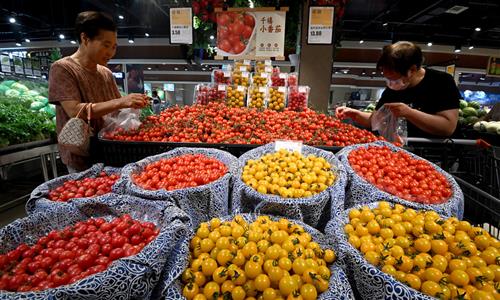China's logistics volume hits 91 trillion yuan in Q1 as macroeconomy maintains recovery trajectory

A truck loaded with mechanical equipment prepares to leave for Ningxia Hui Autonomous Region at a logistics center in Liuzhou, south China's Guangxi Zhuang Autonomous Region, March 12, 2025. (Photo: Xinhua)
China's logistics sector recorded a stable and positive start in the first quarter with significant growth in logistics volume and optimized demand structure, according to data released by the China Federation of Logistics & Purchasing (CFLP) on Tuesday.
The total value of goods flowing through China's logistics system nationwide reached 91 trillion yuan ($12.51 trillion) in the first quarter, registering a year-on-year increase of 5.7 percent, which was 0.4 percentage points higher than the growth rate in the first two months.
The data showed that China's macroeconomy continued its mild recovery trajectory. The supply chain's upstream and downstream segments further consolidated their recovery, logistics operations got off to a stable and positive start, and the demand structure continued to improve, according to the CFLP.
Industrial product logistics volume, which accounted for over 80 percent of the total social logistics volume, grew by 5.9 percent year-on-year, remaining the main driver of logistics demand growth.
"Logistics serves as a leading indicator for the macroeconomy, particularly for the real economy. The accelerated growth pace reflects the sustained recovery of the domestic economy and heightened economic vitality. This positive trend will significantly boost market confidence and is expected to have ripple effects across both the real economy and capital markets," Hu Qimu, a deputy secretary-general of the Digital-Real Economies Integration Forum 50, told the Global Times on Tuesday.
A surging logistics prosperity index also shows that amidst external uncertainties and trade frictions, China's industries are harnessing the domestic market's strength to build resilient supply chains. The smooth domestic circulation is expected to further bolster economic growth and resilience, Hu added.
The growth in industrial product logistics was mainly propelled by high-tech manufacturing and new energy-related industries. Logistics demand for products such as new-energy vehicles, intelligent manufacturing equipment, and photovoltaic devices witnessed rapid growth, indicating the optimization of China's industrial structure, according to Liu Yuhang, director of the China Logistics Information Center.
Policies like large-scale equipment renewal and consumer goods trade-in programs also contributed to the growth of related logistics demand. For example, logistics demand related to general equipment manufacturing and special equipment manufacturing increased by 9.4 percent and 4.1 percent year-on-year. In the consumer goods sector, logistics demand for communication equipment, household appliances, and furniture retail grew significantly, with year-on-year increases of 26.9 percent, 19.3 percent, and 18.1 percent.
The booming emerging e-commerce sectors, such as instant retail and livestreaming, also spurred the growth of online consumption logistics demand. The online retail sales of goods increased by 5.7 percent year-on-year, which is 0.7 percentage points higher than in the January-February period.
The rapid growth in logistics demand for high-tech manufacturing sectors indicates that innovation in new quality productive forces has been effectively translated into industrial value-added, corporate profits, and national GDP, vividly reflecting the rising competitiveness of these industries. Meanwhile, the brisk logistics demand for equipment renewals and consumer goods trade-ins demonstrates that government policies are taking effect, Hu said.
In terms of operation efficiency, the total logistics cost decreased 0.3 percent year-on-year compared to the same period last year.
The logistics enterprises also showed stable business growth and improved operating conditions. The logistics revenue of key surveyed logistics enterprises increased by 6 percent year-on-year, which is 0.4 percentage points higher than that in January-February period. Through intelligent upgrades and improved management, the profit margin remained stable at around 3 percent.
The CFLP said that since March, logistics has shown robust growth across most sectors. This positive momentum is expected to drive the steady expansion of the social logistics volume in the first half of 2025.



